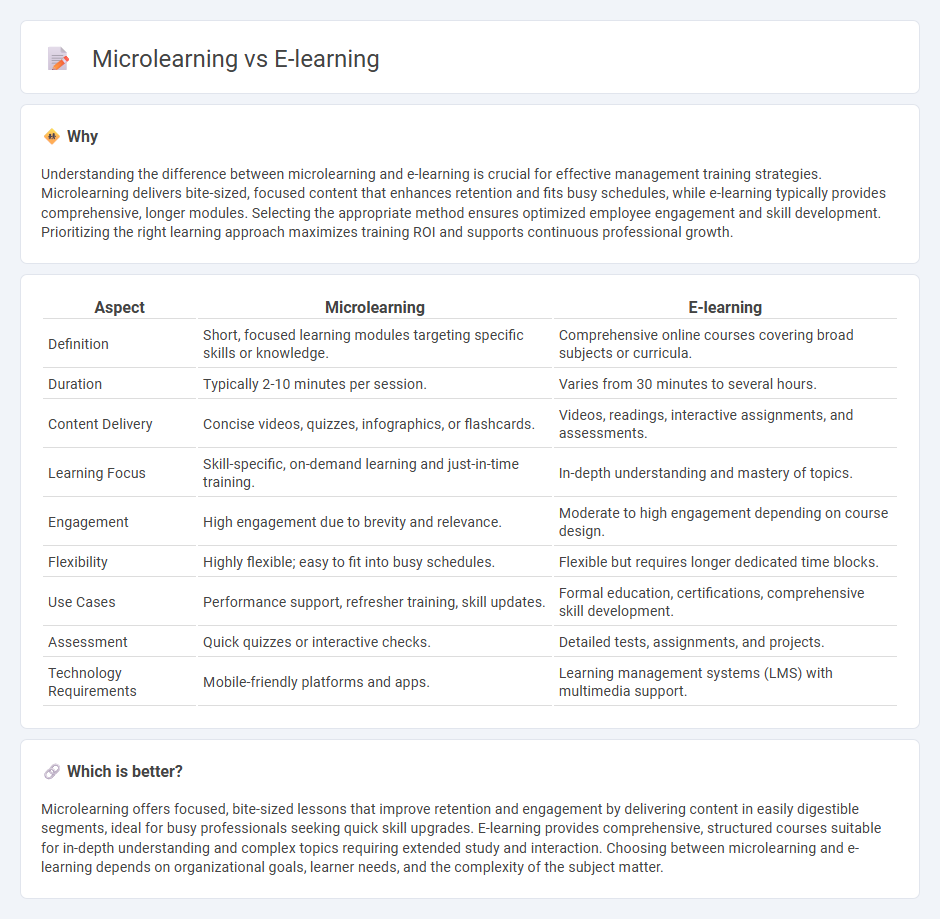
Microlearning delivers focused, bite-sized instructional content designed for quick comprehension and immediate application, enhancing retention and engagement. E-learning encompasses comprehensive courses that provide in-depth knowledge through multimedia formats, supporting diverse learning objectives over an extended period. Explore the differences and benefits to determine the best fit for your organizational training needs.
Why it is important
Understanding the difference between microlearning and e-learning is crucial for effective management training strategies. Microlearning delivers bite-sized, focused content that enhances retention and fits busy schedules, while e-learning typically provides comprehensive, longer modules. Selecting the appropriate method ensures optimized employee engagement and skill development. Prioritizing the right learning approach maximizes training ROI and supports continuous professional growth.
Comparison Table
| Aspect | Microlearning | E-learning |
|---|---|---|
| Definition | Short, focused learning modules targeting specific skills or knowledge. | Comprehensive online courses covering broad subjects or curricula. |
| Duration | Typically 2-10 minutes per session. | Varies from 30 minutes to several hours. |
| Content Delivery | Concise videos, quizzes, infographics, or flashcards. | Videos, readings, interactive assignments, and assessments. |
| Learning Focus | Skill-specific, on-demand learning and just-in-time training. | In-depth understanding and mastery of topics. |
| Engagement | High engagement due to brevity and relevance. | Moderate to high engagement depending on course design. |
| Flexibility | Highly flexible; easy to fit into busy schedules. | Flexible but requires longer dedicated time blocks. |
| Use Cases | Performance support, refresher training, skill updates. | Formal education, certifications, comprehensive skill development. |
| Assessment | Quick quizzes or interactive checks. | Detailed tests, assignments, and projects. |
| Technology Requirements | Mobile-friendly platforms and apps. | Learning management systems (LMS) with multimedia support. |
Which is better?
Microlearning offers focused, bite-sized lessons that improve retention and engagement by delivering content in easily digestible segments, ideal for busy professionals seeking quick skill upgrades. E-learning provides comprehensive, structured courses suitable for in-depth understanding and complex topics requiring extended study and interaction. Choosing between microlearning and e-learning depends on organizational goals, learner needs, and the complexity of the subject matter.
Connection
Microlearning and e-learning are interconnected as microlearning delivers concise, focused educational content through digital platforms typical of e-learning environments. This combination enhances learner engagement and retention by breaking down complex management concepts into easily digestible modules accessible anytime. Organizations leverage microlearning within e-learning to optimize training efficiency and support continuous professional development in management.
Key Terms
Content Delivery
E-learning delivers comprehensive course materials through structured modules that facilitate in-depth knowledge acquisition, often spanning multiple hours or days. Microlearning breaks down content into bite-sized, easily digestible units designed for quick consumption and immediate application, enhancing learner retention and engagement. Discover more about how these content delivery methods impact learning effectiveness and user experience.
Duration
E-learning courses typically range from 30 minutes to several hours, offering comprehensive coverage of topics suitable for in-depth learning sessions. Microlearning breaks content into bite-sized lessons lasting 2 to 10 minutes, designed for quick knowledge absorption and higher retention. Discover how choosing the right duration can enhance your training effectiveness.
Learner Engagement
Microlearning significantly enhances learner engagement by delivering content in short, focused bursts that align with attention spans and facilitate better information retention. E-learning platforms often incorporate multimedia and interactive elements, but lengthy sessions can lead to decreased motivation and cognitive overload. Explore how combining microlearning strategies within e-learning environments can optimize learner engagement and improve training outcomes.
Source and External Links
What is E-Learning? Importance, Benefits and Use Cases - E-learning is instruction delivered online or through a corporate intranet anytime and anywhere, enabling multidirectional communication and flexible learning beyond traditional methods, widely used for student education and employee upskilling in a rapidly changing technology landscape.
eLearning: A Comprehensive Guide - eLearning refers to educational content delivered via digital devices like computers and smartphones, providing convenient, scalable, and personalized learning accessible anytime and anywhere, with a global market projected to reach $1 trillion by 2028.
What Is e-Learning? - Association for Talent Development - eLearning is a structured electronically delivered learning experience that includes various interactive components such as videos, quizzes, and simulations, commonly managed through learning management systems for both synchronous and asynchronous delivery methods.
 dowidth.com
dowidth.com